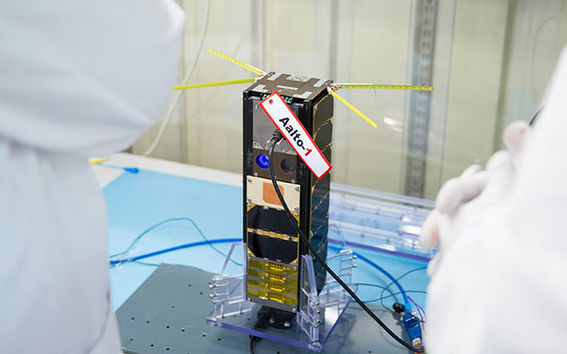Aalto-1 satellite is ready for space

The historic contract for sending the first Finnish satellite into space was signed at the Aalto University School of Electrical Engineering in March 2015. The Aalto-1 satellite is now ready to start its journey to the launch site of the Falcon 9 rocket on the West Coast of the United States. Aalto-1 will be delivered to the site by the Dutch launch service broker Innovative Solutions in Space. The satellite’s journey will begin during the following month and the first stop will be in the Netherlands, where the satellite will be integrated into the launch pad.
‘The satellite is a complicated and sensitive device that has been assembled in a cleanroom. Before Aalto-1 leaves Otaniemi, all humidity is removed from it and the satellite is packed safely for transport. That is how we ensure that the satellite will not carry any extra substances that could cause problems to the satellite or the rocket,’ says Jaan Praks, Professor at Aalto University and the leader of the project.
The satellite has been built and tested in Otaniemi for almost five years. It has gone through dozens of tests, and the very last checks will be carried out in the Netherlands.
‘The functioning of the satellite will be ensured, its electrical system will be set on standby and the satellite will be integrated into the launch adapter in the launch pad, which will be attached to the rocket at the launch site.
The historic rocket launch by the company SpaceX will carry the satellite into space later in spring 2016. In addition to Aalto-1, the rocket will bring a record number of nanosatellites into orbit at 600km.
Miniature state-of-the-art technology
Aalto-1 is a modern nanosatellite based on the CubeSat standard and contains state-of-the-art technology from Finland. The satellite can carry three research devices: an imaging spectrometer built by VTT, a radiation monitor jointly constructed by the Universities of Helsinki and Turku and a plasma brake developed by the Finnish Meteorological Institute, which is based on the principle of an electric solar sail and aimed at reducing the amount of space debris.
‘Two satellites have been built. The flight model will travel into space and the engineering model will stay in Otaniemi. This way we can test unexpected situations by using the engineer model on Earth first,’ says Praks.
More than 80 students have taken part in the project and dozens of related master's and bachelor's theses, many conference publications and scientific publications have been completed. Students have themselves designed the entire satellite and several of its subsystems, such as the radios, framework, antennas and solar panels, which provide the electricity needed for the satellite. The brain of the satellite, i.e. the main computer, will transmit all necessary information from space to the ground station in Otaniemi.
‘Our work will not end when the satellite is launched as it will be monitored from Otaniemi for an estimated period of two years. The satellite has three important tasks, or missions, to carry out,’ Praks reminds us.
Joint journey to space
Several experts, research institutes and companies have provided assistance to the project. Along with development work on the research devices carried by the satellite, the project has worked in co-operation with companies such as Space Systems Finland, which has made its laboratory facilities available
to the project work group. Some project members have also done internships with Berlin Space Technologies. Project partners have provided thesis opportunities, design assistance and even jobs to project members.
Completion of the satellite demonstrates the high level of education at Aalto University. The new generation of nanosatellites involves technological developments, the results of which can also be used in other fields.
'The competence and expertise gained during development of the satellite will also have a direct impact on development in other application areas. Designing instruments for use in highly demanding conditions helps us create innovations and teaches us to appreciate and build quality,' says Praks.
More information:
Professor, leader of the project Jaan Praks
Aalto University
[email protected]
tel. +358 50 420 5847
In addition to development of the research equipment carried by the satellite, the following actors have also collaborated with the project: SpaceSystems Finland, RSI Solutions, IBS Berlin Space Technologies, the University of Eastern Finland, the University of Jyväskylä, Aboa Space Research Asro, Tartu Observatory, Clyde Space, Hyperion Technologies and the Turku University of Applied Sciences.
SpaceSystems Finland and Nokia as well as the University of Turku and RUAG support the launch of the satellite.
- Published:
- Updated:
Read more news

Get to know us: Associate Professor Maria Sammalkorpi
Sammalkorpi received her doctorate from Helsinki University of Technology 2004. After her defence, she has worked as a researcher at the Universities of Princeton, Yale and Aalto.
Aalto computer scientists in ICML 2024
Computer scientists in ICML 2024
In low-hierarchy organisations, even key policy issues are discussed in Slack
In a recent study, Aalto University alumn Lauri Pietinalho, a visiting scholar at New York University's Stern School of Business, and Frank Martela, an assistant professor at Aalto University, investigated how low-hierarchy organisations deal with shared policies in confrontational situations and how authority functions within them.